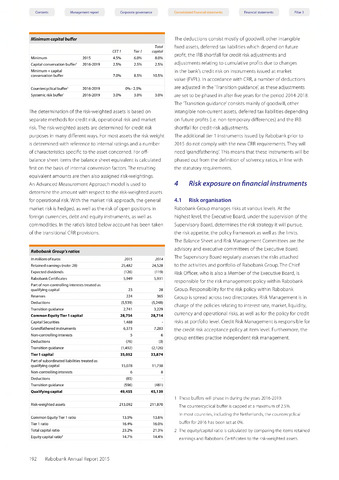-
-
4 Risk exposure on financial instruments
Contents Management report Corporate governance Consolidated financial statements Financial statements Pillar 3
Minimum capital buffer
CET1
Tier 7
Total
capital
Minimum
2015
4.5%
6.0%
8.0%
Capital conservation buffer1
2016-2019
2.5%
2.5%
2.5%
Minimum capital
conservation buffer
7.0%
8.5%
10.5%
Countercyclical buffer1
2016-2019
0
i% - 2.5%
Systemic risk buffer1
2016-2019
3.0%
3.0%
3.0%
The determination of the risk-weighted assets is based on
separate methods for credit risk, operational risk and market
risk.The risk-weighted assets are determined for credit risk
purposes in many different ways. For most assets the risk weight
is determined with reference to internal ratings and a number
of characteristics specific to the asset concerned. For off-
balance sheet items the balance sheet equivalent is calculated
first on the basis of internal conversion factors. The resulting
equivalent amounts are then also assigned risk-weightings.
An Advanced Measurement Approach model is used to
determine the amount with respect to the risk-weighted assets
for operational risk. With the market risk approach, the general
market risk is hedged, as well as the risk of open positions in
foreign currencies, debt and equity instruments, as well as
commodities. In the ratio's listed below account has been taken
of the transitional CRR provisions.
Rabobank Group's ratios
in millions of euros
2015
2014
Retained earnings (note: 28)
25,482
24,528
Expected dividends
(126)
(119)
Raboban k Certificates
5,949
5,931
Part of non-controlling interests treated as
qualifying capital
23
28
Reserves
224
365
Deductions
(5,539)
(5,248)
Transition guidance
2,741
3,229
Common Equity Tier 1 capital
28,754
28,714
Capital Securities
1,488
Grandfathered instruments
6,373
7,283
Non-controlling interests
5
6
Deductions
(76)
(3)
Transition guidance
(1,492)
(2,126)
Tier 1 capital
35,052
33,874
Part of subordinated liabilities treated as
qualifying capital
15,078
11,738
Non-controlling interests
6
8
Deductions
(85)
Transition guidance
(596)
(481)
Qualifying capital
49,455
45,139
Risk-weighted assets
213,092
211,870
Common Equity Tier 1 ratio
13.5%
13.6%
Tier 1 ratio
16.4%
16.0%
Total capital ratio
23.2%
21.3%
Equity capital ratio2
14.7%
14.4%
The deductions consist mostly of goodwill, other intangible
fixed assets, deferred tax liabilities which depend on future
profit, the IRB shortfall for credit risk adjustments and
adjustments relating to cumulative profits due to changes
in the bank's credit risk on instruments issued at market
value (FVPL). In accordance with CRR, a number of deductions
are adjusted in the 'Transition guidance', as these adjustments
are set to be phased in after five years for the period 2014-2018.
The 'Transition guidance' consists mainly of goodwill, other
intangible non-current assets, deferred tax liabilities depending
on future profits (i.e. non-temporary differences) and the IRB
shortfall for credit-risk adjustments.
The additional tier 1 instruments issued by Rabobank prior to
2015 do not comply with the new CRR requirements.They will
need 'grandfathering'.This means that these instruments will be
phased out from the definition of solvency ratios, in line with
the statutory requirements.
4.1 Risk organisation
Rabobank Group manages risks at various levels. At the
highest level, the Executive Board, under the supervision of the
Supervisory Board, determines the risk strategy it will pursue,
the risk appetite, the policy framework as well as the limits.
The Balance Sheet and Risk Management Committees are the
advisory and executive committees of the Executive Board.
The Supervisory Board regularly assesses the risks attached
to the activities and portfolio of Rabobank Group.The Chief
Risk Officer, who is also a Member of the Executive Board, is
responsible for the risk management policy within Rabobank
Group. Responsibility for the risk policy within Rabobank
Group is spread across two directorates. Risk Management is in
charge of the policies relating to interest rate, market, liquidity,
currency and operational risks, as well as for the policy for credit
risks at portfolio level. Credit Risk Management is responsible for
the credit risk acceptance policy at item level. Furthermore, the
group entities practise independent risk management.
1 These buffers will phase in during the years 2016-2019.
The countercyclical buffer is capped at a maximum of 2.5%.
In most countries, including the Netherlands, the countercyclical
buffer for 2016 has been set at 0%.
2 The equity/capital ratio is calculated by comparing the items retained
earnings and Rabobank Certificaten to the risk-weighted assets.
192 Rabobank Annual Report 2015

